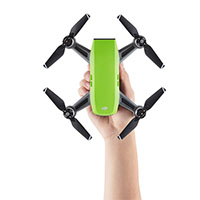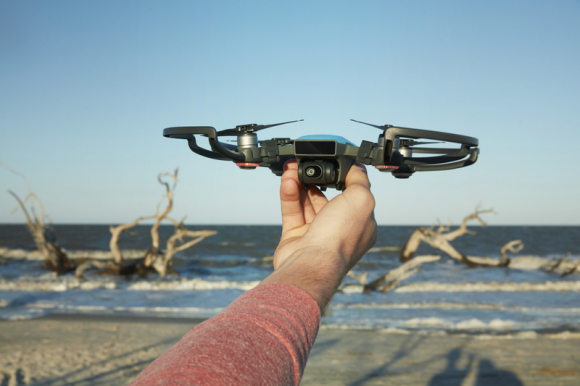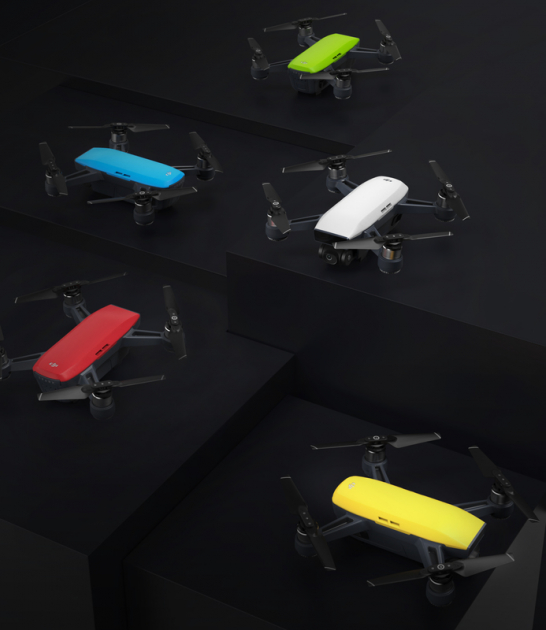DJI launches Spark, their palm-sized consumer-friendly drone
posted Wednesday, May 24, 2017 at 12:30 PM EDT

DJI has announced their latest drone, Spark, and it's the smallest flying camera they have ever revealed. Even smaller than the Mavic, the Spark weighs a mere 10.6 ounces but still comes with packed with familiar features like obstacle avoidance, indoor operation and intelligent flight modes, but has a new controller: you. The Spark has a "Gesture Mode," and DJI says that all you'll need to control Spark is your hand, making it the first drone that can be fully controlled by gestures alone.
When Spark takes off from your hand, it automatically enters Gesture Mode. This features new advanced gesture controls like PalmControl, which lets you control Spark with hand movements (indoors, DJI strongly recommends you use the included propeller guards). In Gesture Mode, you can also send Spark up and away from you, take a selfie, and call it back with just your hands.
"Spark has been designed to be the perfect lifestyle accessory you can take anywhere," DJI says. "It fits easily in almost any bag and weighs just 10.6 ounces (300 grams) – less than a can of soda. Spark is ready to launch within seconds whenever inspiration strikes and can be operated by a remote controller, a mobile device, or hand gestures alone. Spark will be available in five different colors: Alpine White, Sky Blue, Meadow Green, Lava Red, and Sunrise Yellow."
Spark comes packaged with new flight options, like QuickShot Intelligent Flight Mode. This mode allows you to create "professional" videos easily and quickly. You can select a Quickshot, and Spark will fly along a preset flight path while recording and tracking a subject. Four QuickShots are available:
- Rocket: sending Spark straight up into the air with the camera pointed down
- Dronie: flying up and away from your subject
- Circle: rotating around the subject
- Helix: spiraling away from a subject as it flies upward
For each QuickShot, Spark will automatically create a 10-second video from your flight that is ready to share on social media.
Previously introduced Intelligent Flight Modes such as TapFly and ActiveTrack can also be found on Spark. Developed based on DJI's vision technology, a new TapFly sub mode called Coordinate allows Spark to fly to a location you tap on your mobile device screen. TapFly’s Direction Mode lets you keep flying in the direction you tap on the screen. Using ActiveTrack, Spark will automatically recognize and track an object you choose, keeping it at the center of the frame for perfect shots of objects in motion. Whether you are using TapFly or tracking a subject, Spark’s 3D Sensing System will actively sense obstacles in front of the aircraft.

Spark includes many previous DJI drone shooting modes with two new additions: Pano and ShallowFocus. In Pano Mode, the camera creates horizontal or vertical panoramas by automatically adjusting its gimbal and heading, taking a series of pictures and stitching them together. ShallowFocus allows you to put part of a picture into sharp focus while the rest of the image is softened, creating photographs with a shallow depth of field. An array of filters and automatic editing templates available in the DJI GO 4 app enables creators to quickly edit videos and share them directly to Facebook, YouTube, Twitter, Instagram, and other social media platforms.
With the remote controller accessory, you can switch to Sport Mode and see Spark's speed potential of up to 31 mph (50 kph). Sport Mode sets the gimbal to first-person view (FPV) by default, so the camera moves with you as you fly. Spark will also be compatible with DJI Goggles for an immersive FPV flight experience.
The camera is where Spark and Mavic really see a large difference: Spark is clearly a more consumer-oriented drone. Spark houses a camera with a 1/2.3” CMOS sensor that captures 12 megapixel photos and shoots stabilized HD 1080p videos, not 4K. Spark comes with a 2-axis mechanical gimbal and DJI's UltraSmooth technology for smooth shots with limited rolling shutter.
Spark’s FlightAutonomy system consists of the main camera, a downward-facing vision system, a forward-facing 3D Sensing System, dual-band GPS and GLONASS, a high-precision inertial measurement unit, and 24 computing cores. These features allow Spark to hover accurately with vision system assistance at up to 98 feet (30 meters) and sense obstacles from up to 16 ft (5 m) away.
Like all recent DJI drones, Spark can return to its home point automatically with a sufficient GPS signal. While using the remote controller, if the battery gets too low, connection is lost, or the operator presses the Return to Home (RTH) button, Spark flies back to the preset home point while sensing obstacles in its path. Spark also integrates DJI’s GEO System or NFZ geofencing to provide you with up-to-date guidance on areas where flight may be limited by regulations or raise safety or security concerns.

For optimal performance, Spark is powered by a high-energy density LiPo battery and has a maximum flight time of up to 16 minutes. When flying with the remote controller accessory, Spark allows for 720p real-time video transmission from up to 1.2 miles (2 km) away.
The US retail price of a DJI Spark, including an aircraft, a battery, a USB charger and three pairs of propellers, is $499 USD. The Spark Fly More Combo includes an aircraft, two batteries, four pairs of propellers, a remote controller, propeller guards, a charging hub, a shoulder bag and all necessary cables, with a US retail price of $699 USD. Pricing and availability of other accessories for Spark will be announced at a later date.